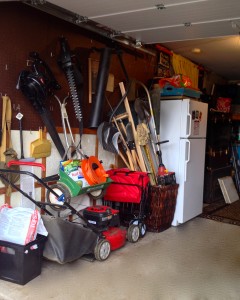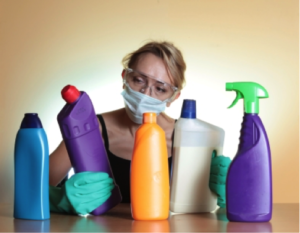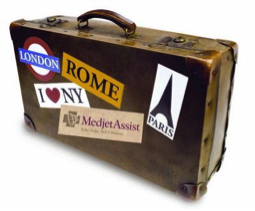 Did you know that there is a ‘National Clean Out Your Garage Day?’ Well, sure enough there is, and it was last Saturday, September 12, 2015. Why not take advantage of the beautiful, upcoming autumn season, and get the process started?
Did you know that there is a ‘National Clean Out Your Garage Day?’ Well, sure enough there is, and it was last Saturday, September 12, 2015. Why not take advantage of the beautiful, upcoming autumn season, and get the process started?
Purging your garage and utilizing all the space your driveway affords, is the perfect spot to sort through all the clutter that you’ve accumulated over the years. Soon enough, you’ll need your Halloween décor and Thanksgiving Day bin, and if you’re anything like me, you’ve been busy entertaining, traveling, and heading to the pool all summer. Believe it or not, even as a professional organizer, my garage tends to get messy. There’re serving platters from my last social gathering, cases of beverages that haven’t been placed into the garage fridge yet, suitcases from our last trip, my pool chairs, and my cooler which I bring to the shore on the weekends. Also, I have my donation bags that I fill year round, electronics that I plan to recycle for my clients, and gardening tools that I keep on the floor for ongoing projects.
Below are some helpful tips to help you get the process started:
–Set up bins & trash bags in the driveway labeled donate, shred, trash, recycle, & sell. Keep in mind that most liquor stores give boxes away for free, and they are small enough to handle when heavy.
–Put everything that is on the floor outside in the driveway. Now you can walk safely around your garage. Sweep and dust as you go.
–Make a plan as to where you’re going to store your belongings. For example, garden supplies on this wall, tools here & seasonal items there. Set it up like a little store. Use temporary labels for your specific zones.
–Start sorting like with like. Maybe you’ll need some shelving. Personally, I like Gorilla shelves or clear bins. Also, I use nice big labels on all sides of the bins and on the shelves.
Even though ‘National Clean Out your Garage Day‘ is history, the present state of your garage may require your getting it done even though it is a few days or weeks later. If the task seems a little daunting, that’s the perfect time to ask for a some help. Professional organizers are well equipped to help with the most exhausting of projects. You’ll get it done right, and you’ll get it done quickly!
 Eventually, the time may come when you feel like the amount of ‘stuff’ you have surrounded yourself with in your home is beginning to have a negative effect on you. For years, those items may have brought you comfort. However, now you may feel claustrophobic in your own personal space. When those feelings begin to occur, and you want to make a change but do not know how, that is usually when it’s time to call a professional organizer.
Eventually, the time may come when you feel like the amount of ‘stuff’ you have surrounded yourself with in your home is beginning to have a negative effect on you. For years, those items may have brought you comfort. However, now you may feel claustrophobic in your own personal space. When those feelings begin to occur, and you want to make a change but do not know how, that is usually when it’s time to call a professional organizer.
The most common description I hear when a potential organizing client calls me is; “I am so overwhelmed.” Upon arriving at the home, I may also hear “I’m so embarrassed,” or “Have you ever seen anything this bad before?” Let me put your mind to rest. As an organizer, I am not there to judge. I am there to help. Professional organizers want to help or we would not be in this profession.
It’s not always easy to clear away things you’ve amassed in your home, whether they are collectibles or household items that just seem to keep accumulating. When sorting through excess things in your home, whether you consider those items clutter or treasured keepsakes, please understand that organizing is a process that takes time. It involves purging, separating, and categorizing every individual piece to achieve the desired results.
Others that are not experiencing the same emotional issues as you when it comes to de-cluttering may have no empathy for your situation. They tell you to “toss it,” or “just throw that stuff out”. Letting go of items can be a daunting task and working with an understanding expert is invaluable whether you wish to accomplish an organized desk, office, closet, room or your entire home.
Your professional organizer will not only facilitate this process, but bring you a sense of calm and understanding as you work through this course of action together. Please don’t misunderstand, it is important for you, as the owner of the possessions, to be a part of this decision making process. Otherwise, you may only be relocating items from one space to another.
Professional organizers can be likened to life coaches, who are defined as somebody who provides advice and support to people who wish to improve their lives, helping them to make decisions, solve problems, and achieve goals. I often hear “I know I should be able to do this on my own, but I can’t seem to make myself do this without you.” Guess what, that’s ok. That comfort, guidance and understanding is much of what we, as professional organizers, bring to you. Of course, we also have the obvious capability to assess and accelerate your project, and then bring it all together with our uncanny sense of space planning to give you a tidy new space.
And isn’t that what you wanted all along; an organized space, free of clutter, that you can find comfort in, and be proud to call your own?
 Most of us haven’t taken a close look at the chemical content of our common household cleaners, skin care products and makeup to find out that there are dangerous chemicals lurking in the ingredients list. The next time you are clearing out your cabinets by yourself or with one of us, Professional Organizers, don’t just look at the expiration dates, check the ingredients and keep the information below in mind.
Most of us haven’t taken a close look at the chemical content of our common household cleaners, skin care products and makeup to find out that there are dangerous chemicals lurking in the ingredients list. The next time you are clearing out your cabinets by yourself or with one of us, Professional Organizers, don’t just look at the expiration dates, check the ingredients and keep the information below in mind.
I went to a meeting hosted by Physicians for Social Responsibility, a group that looks at potential hazards facing our society. At the meeting, they showed a short video by Annie Leonard called the “Story of Cosmetics.” The video was followed by a discussion questioning the pervasive use of toxic chemicals in our beauty products, from lipstick to baby shampoo, chemicals that are known to contain carcinogens, neurotoxins, reproductive toxins and heavy metals, like lead and mercury. I was shocked to find out that lipsticks contain lead. Although I understand that it is hard to live in a lead free world, as Annie Leonard questions, “Do we have to put lead in our lipsticks?” I even found this to be the case when I went searching for new lipsticks in Whole Foods in the “organic” cosmetic department!
Harmful chemicals are not just in our cosmetic bags. Our homes are filled with fumes from harmful petrochemical solvents that are added to everyday house cleaners. “The average household contains anywhere from 3 to 25 gallons of toxic materials, most of which are in cleaners,” notes Ava Anderson, a young entrepreneur, who at age 14 went in search of personal care products that did not contain harmful chemicals and couldn’t find any. In response, Ava started her own company selling healthier choices for skin care and cleaning products. At the heart of her company is a commitment to educate the public about the chemical content in products we use without worry or concern for their potential cumulative and lasting effects to our health and wellbeing.
Like Annie Leonard, Ava’s research finds disturbing facts that most of us do not know, facts that might shape our buying habits moving forward. Below are highlights from Ava’s list:
Below are Gaiam Life’s “8 Household Cleaning Agents to Avoid” and why:
The “All You” website also has a list of 6 chemical hazards hiding in your home, for those of you who are interested in more information.
If like me, after confronting this information, you’re heading to your cupboards, toiletry bags and makeup kit to do some tossing, the next question would be, “then what can I use instead?” Below are suggestions to get you started using baking soda, white vinegar, fresh lemons and coconut oil.
Baking Soda
Here are suggested uses for baking soda from The Farmer’s Almanac and “All You” websites:
White Vinegar
White vinegar can replace many common cleaning products you now may want to avoid. Here are suggestions from the “All You” website:
Lemons
Lemons offer alternatives to both cleaning products and beauty care. Here are suggestions from the “All You” website:
Coconut Oil
Coconut is the newest addition to my healthier cabinets & toiletry bag. Here are some of my favorites uses from the “Derm Store.”
Well, I hope you found some good, enticing alternative product ideas for your mop closet and makeup bag. It has been fun trying out and discovering healthier products and now, sharing them with all of you. May you too enjoy your journey towards healthier products.
 To roll or not to roll…that is the question. There’s a lot of debate about the best way to pack a bag for travel. We’ve used three different methods with our clients. The best method depends on the purpose of the trip, the kind of clothing you are taking, if you prefer hanging your clothes at your destination and wrinkle control.
To roll or not to roll…that is the question. There’s a lot of debate about the best way to pack a bag for travel. We’ve used three different methods with our clients. The best method depends on the purpose of the trip, the kind of clothing you are taking, if you prefer hanging your clothes at your destination and wrinkle control.
Layering
In the layering or bundling method, layer the clothes in a crisscross fashion in the suitcase and intertwine them into a bundle. This is a great method to reduce wrinkles and we were easily able to pack as many as 25 items of medium sized women’s clothing in one 22” carry-on. The downside is that the entire bundle has to be removed and unwrapped to retrieve your clothing.
Rolling
Rolling the clothing is another popular method. You can roll each item individually or group like items together and roll as a bundle. We found that grouping like items together does save some extra space and reduce some of the wrinkling that can occur with various fabrics when rolled.
Folding
And finally, the folding method. This method does take up more space than layering or rolling. However, for some fabrics, it’s a better way to reduce wrinkling. Folding the clothing with a piece of tissue paper or plastic in the middle will reduce friction and therefore the wrinkles.
In the end, we found that a combination of methods often works best. Rolling items that don’t wrinkle easily and folding others with plastic were the easiest techniques to combine. Once the larger, bulkier items were placed in the suitcase, we filled in all the gaps with smaller items like underwear, tank tops, bathing suits and belts, so that every nook and cranny was filled.
Believe it or not, it has taken me over three years to convince someone very near and dear, to let me help get her closet in order. And, she has recommended me to many of her friends and family. Go figure. Let me elaborate: for the past three years, I have continually heard:
• “I am so frustrated with getting dressed in the morning!”
• “I can’t seem to get out of the house on-time!”
• “I just don’t know what to wear!”
• “I never used to have this issue. Putting outfits together was not a problem, before.”
My response was always, “Why don’t I come over and help you?” Her reply was always, “No, you’ll make me get rid of too many things I really like!”
Nothing could be further from the truth. No worthwhile professional organizer should have an aggressive, ‘It’s my way or the highway attitude.’ Coming into anyone’s home like a steamroller is contrary to the nature of our profession. Working with those who need some organizational strategies is a delicate process. All that’s required is motivation, trust, transparency, an open mind to change, and a friend to help.
Recently, this same person had been invited to a wedding. What she asked of me was the opportunity I was looking for. She wanted me to help her choose an outfit, from her wardrobe for the occasion. Together, we chose the dress, jewels, purse, and shoes. She thanked me graciously and told me she had so many clothes, it was stressful getting dressed each morning. I suggested the both of us go through everything she had on hand and do some ‘Spring Wardrobe Cleaning.’ She was so excited and blurted out, “Can we start now?
First, I asked her to go through her closet and remove any items that have not been worn in the last 6 months to a year. We accumulated a pile of about fifteen pieces, which we put aside for donation. Then I suggested she try on each remaining item, while keeping in mind style, comfort, and flattering fit. Moving on, we removed all items that were not in season. This, in and of itself, freed a lot of space in her closet. Lastly, I coordinated numerous outfits for her which consisted of multiple tops to be worn with her selection of slacks or skirts. I moved the coordinated outfits to one side of her closet and categorized what was left by item and color on the other side.
Her only negative concern was the clothes to be donated. That quickly dissipated as I explained that I would handle dropping them off. She was extremely grateful for the gentle nudge especially after I explained how rewarding it is to donate to those less fortunate. The sense of relief she felt was obvious and palpable. We still have to conquer the bureau drawers and fall closet, but I’m not a bit concerned. With the success of the ‘initial purge,’ from here on it’s just a matter of baby steps.
Do you dread entering your laundry area because it’s filled with piles of dirty clothes and who knows what else? Now is a good time to make a clean, fresh start!
1. Visualize your ideal space.
· Picture how you would like the room to look and consider how it should better function.
2. Reduce the excess.
· Remove items that don’t belong in the laundry room and put them where they really should live.
· Eliminate items you don’t want (use up, share with others, donate, or toss).
3. Maximize the space.
· Install shelves or cabinets above and/or next to washer and dryer.
· If space allows, place a narrow rolling cart between your washer and dryer to store small items.
· Install a wall-hanging ironing board, hanging rack and/or folding table to save space.
4. Organize what you keep.
· Assign a home for each item, keeping similar items together.
· Keep frequently-used items close at hand and less-frequently used items higher or lower.
· Dedicate space for sorting dirty clothes; use bins or rolling carts to separate and contain whites, colors, delicates, and heavily soiled items.
6. Decorate the room.
· Hang artwork, put down a throw rug, purchase attractive hampers, etc. so you feel happy and peaceful in the room.
7. Develop a laundry schedule.
· Make doing laundry a ROUTINE – daily, every other day, weekly, etc.
· Make it as enjoyable as possible – fold laundry while watching TV, talking on phone, etc.
8. Get help from family members.
· Have family members empty pockets, pre-spot and put their dirty clothes in the hamper.
· Delegate the folding of clean laundry and putting clothes away.
9. Follow through!
· Complete the laundry cycle and put clothes away and have family members do the same.
· Reward yourselves with a treat when you’ve completed the process.
BONUS TIP #1: To have a truly clean start, take your accumulated laundry to your local laundromat and have them do the wash for you. Approximate cost = $1.00/lb.
BONUS TIP #2: Use Color Catchers (by Shout) or Color Grabber (by Carbona) when washing lights and darks together. They really do catch the color!